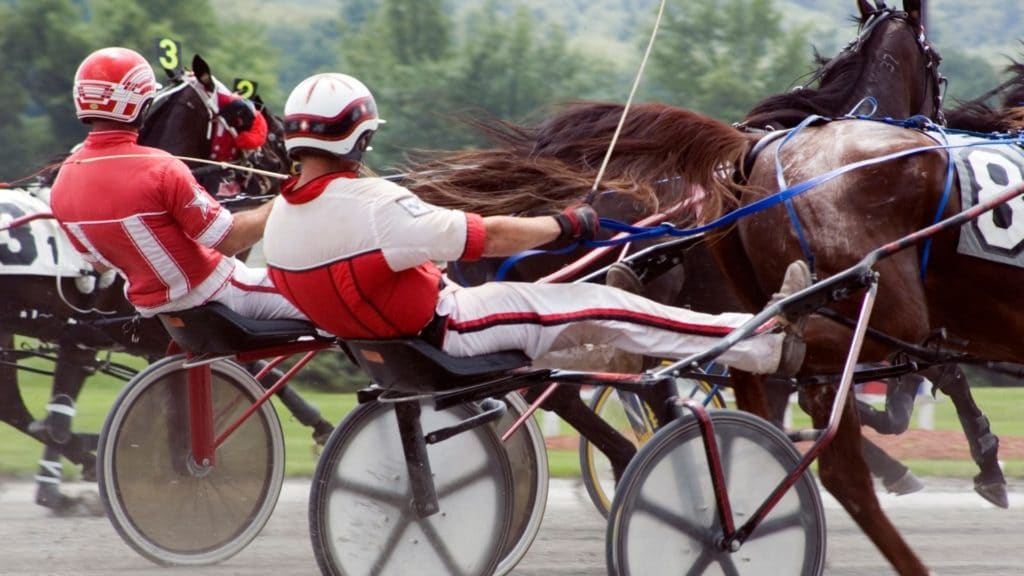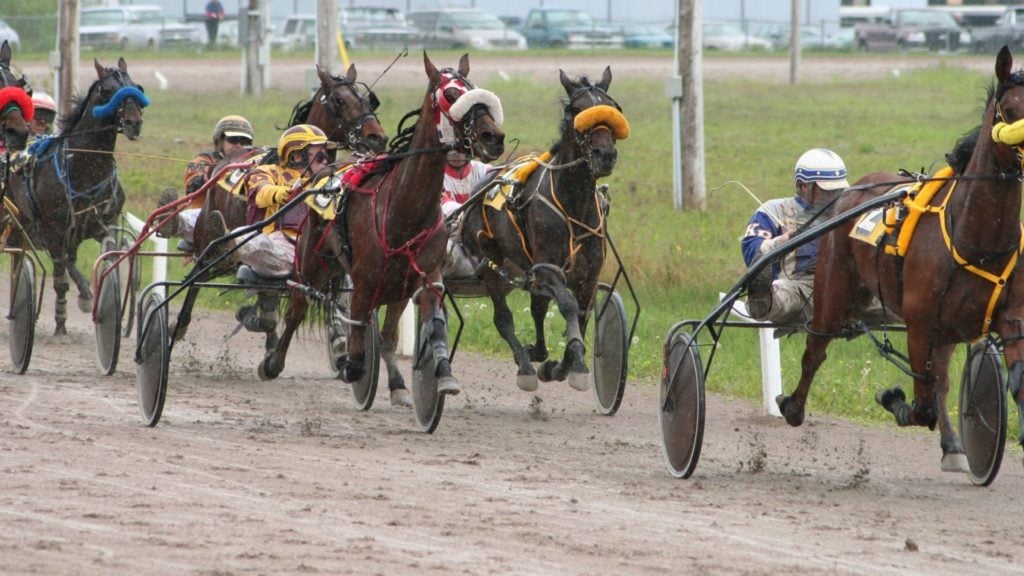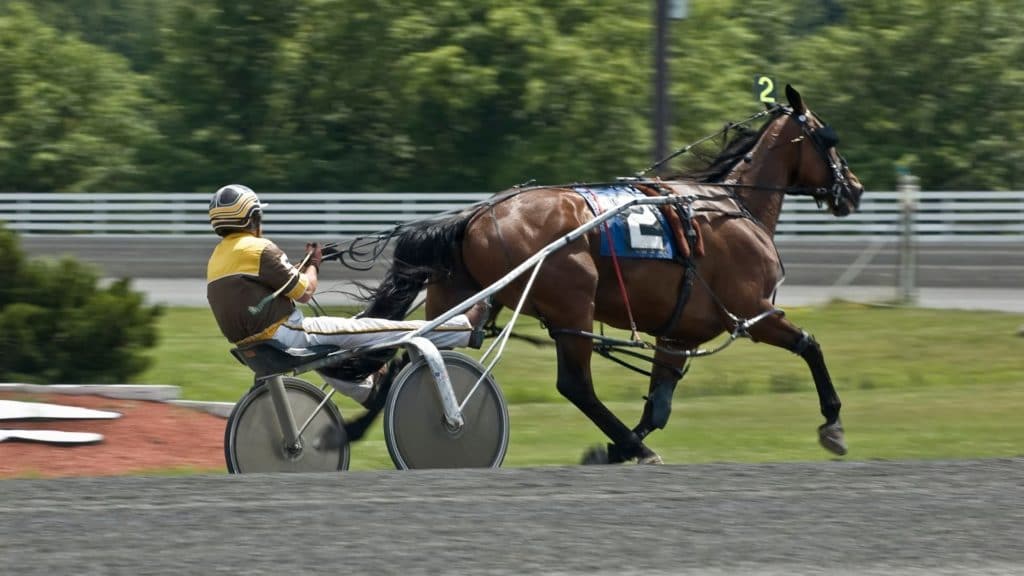Last updated: September 26, 2024
When my friend raved about the thrill of watching a sulky race, I realized the need to spotlight and explain this riveting sport to others.
Harness racing features horses pulling a “sulky”—a lightweight, two-wheeled cart—using distinctive trotting or pacing strides. While the sport has fervent fans across the globe, especially in regions like New Zealand, Australia, North America, and Europe, its depth and intricacies are often overlooked.
Sulky racing has a rich story, from its history to the special horse breeds and training methods. The sulky, or the cart they pull, plays a big role in the sport. Join us to learn about the amazing skills of the horses and get some betting tips to make watching even more fun.

History of Harness Racing
Harness racing traces its roots back to ancient chariot races, which were popular in places like Greece, Rome, and Egypt. As time went by, the sport evolved into its current form, with horses pulling lightweight, two-wheeled carts called “sulkies.” This transformation allowed for a more intimate connection between the horse and its driver, as well as a greater focus on the horse’s gait and performance.
Over the centuries, harness racing gradually spread across the globe. It first gained popularity in Europe, where passionate fans in countries like France and Sweden embraced the sport. As people traveled and settled in new lands, they took their love for harness racing with them. This global migration led to the sport’s introduction in regions such as North America, Australia, and New Zealand.
In the United States, harness racing’s popularity soared in the 19th and early 20th centuries. Enthusiasts flocked to county fairs and dedicated tracks, where they witnessed the thrilling races and placed bets on their favorite horses. The sport’s fan base continued to grow, and soon, it gained a strong following in Canada as well.
Today, harness racing is an integral part of the global horse racing community, attracting fans and participants from all walks of life. Major events, such as the prestigious Hambletonian and the Inter Dominion Championship, draw large crowds and showcase the incredible skill and athleticism of both the horses and their drivers.
The Sulky: Key Component of Harness Racing
In the ever-evolving world of harness racing, the invention of the sulky revolutionized the sport. This seemingly simple two-wheeled cart played a pivotal role in transforming harness racing into the thrilling spectacle it is today.
The sulky’s purpose is to carry the driver, allowing them to guide and control the horse as it races around the track. Its lightweight construction and streamlined design enable the horse to maintain its natural gait, trotting, or pacing while minimizing the impact on its speed and performance.
In the early days of harness racing, sulkies came in various shapes and sizes, each with its own advantages and drawbacks. There were high-wheeled sulkies, which offered better visibility for the driver but were less stable, and low-wheeled sulkies, which provided a smoother ride but limited the driver’s view of the track. As the sport grew in popularity, the need for more efficient and standardized sulky designs became apparent.
Over time, technological advancements and innovative thinking led to the development of new and improved sulky designs. One such breakthrough was the introduction of the “bicycle sulky” in the late 19th century. This design featured large, pneumatic tires that greatly improved the cart’s stability and maneuverability, allowing the horses to achieve faster speeds.
Another significant innovation came in the form of the “offset sulky,” which repositioned the driver to one side of the cart, reducing the weight on the horse’s back and enabling it to maintain a more consistent gait. This design further enhanced the horse’s performance and made for even more thrilling races.
In recent years, the sulky has continued to evolve, with manufacturers incorporating lightweight materials like carbon fiber and aluminum to further reduce the cart’s weight. These advancements have led to faster race times and even greater excitement for spectators and participants alike.
The sulky’s journey, from its humble beginnings to its current state-of-the-art design, is a testament to the ongoing passion and innovation that drive the world of harness racing. As a key component of the sport, the sulky plays an essential role in showcasing the incredible skill and athleticism of the horses and drivers that captivate audiences around the globe.
Harness Racing vs. Thoroughbred Racing
In the enchanting realm of horse racing, two distinct styles have captured the hearts of fans worldwide: harness racing and thoroughbred racing. While they share similarities, such as the exhilarating speed and the thrill of competition, these two racing styles have unique characteristics that set them apart.
One primary difference between the two lies in the type of race. In harness racing, horses pull a lightweight, two-wheeled cart called a sulky while maintaining either a trotting or pacing gait. In thoroughbred racing, on the other hand, jockeys ride atop the horses, who gallop at full speed toward the finish line.
The horse breeds involved in these racing styles also vary. Harness racing predominantly features the versatile and agile Standardbred breed, known for its exceptional trotting and pacing abilities. In contrast, thoroughbred racing showcases the speed and stamina of Thoroughbreds, a breed specifically developed for flat-out galloping.
Training and race preparation for each racing style are tailored to the unique requirements of the respective sport. Harness racing horses undergo rigorous training to master their specific gait, either trotting or pacing and learn to work in harmony with their drivers. This process often involves building up the horse’s strength, stamina, and coordination and refining their response to the driver’s commands.
Thoroughbred racehorses, on the other hand, are trained to reach top speeds while carrying a jockey. Their training focuses on developing their galloping ability, cardiovascular fitness, and overall strength to endure high-intensity races. Additionally, jockeys must learn to communicate with their horses effectively, guiding them through the race while conserving their energy for the final sprint.
Despite their differences, both harness racing and thoroughbred racing share a common goal: to celebrate the remarkable athleticism, speed, and grace of these incredible equine athletes. Whether you’re drawn to the rhythmic trotting and pacing of harness racing or the exhilarating gallop of thoroughbred racing, these captivating sports offer unforgettable experiences that continue to delight fans across the globe.
The Thrill of Sulky Racing Events
The heart-pounding excitement of harness racing comes to life at prestigious events, renowned racetracks, and through the incredible achievements of legendary horses and drivers. These unforgettable moments create lasting memories for fans and participants alike, showcasing the exhilarating spirit of the sport.
Major races and championships
- The Hambletonian: Held annually in the United States, this race is considered one of the most prestigious events for trotters, drawing large crowds and top contenders.
- The Little Brown Jug: A prominent race for pacers, this event is part of the Triple Crown of Harness Racing for Pacers in the United States.
- The Prix d’Amérique: In France, this esteemed race is recognized as one of the world’s most challenging trotting events, featuring top international competitors.
- The Inter Dominion Championship: A prestigious event held in Australia and New Zealand, it alternates between trotting and pacing races each year, showcasing the best talent from both countries.
Notable harness racing tracks
- Meadowlands Racetrack: Located in New Jersey, USA, this track is known for hosting the Hambletonian and the Meadowlands Pace, attracting top-notch horses and drivers.
- Vincennes Racetrack: Situated in Paris, France, it is home to the prestigious Prix d’Amérique and other significant European harness racing events.
- Yonkers Raceway: A historic track in New York, USA, it offers year-round harness racing and hosts the famous International Trot.
Horses
- Niatross: A pacing superstar, he set multiple world records and dominated the sport in the late 1970s and early 1980s.
- Moni Maker: An exceptional trotter, she enjoyed a long and illustrious career, winning numerous races in the United States and Europe.
- Cambest: This legendary Standardbred holds the world record for the fastest mile paced by a Standardbred, clocking in at an astonishing 1:46.1 in 1993.
- Sebastian K: Another record-breaking Standardbred, Sebastian K set the world record for the fastest mile trotted by a Standardbred in 1:50.0 in 1993.
Drivers
- Hervé Filion: A prolific driver, he held the record for most career wins for several decades, earning countless accolades throughout his career.
- John Campbell: Often regarded as one of the greatest harness racing drivers, he has achieved numerous victories in high-profile races and championships.
The thrill of harness racing events, from major races to the legendary figures that grace the tracks, showcases the passion, skill, and dedication that define this captivating sport. As fans and participants come together to celebrate these exciting moments, they create a shared appreciation for the extraordinary world of harness racing.
Horse Racing with a Cart.
Harness racing is a horse racing variety in which horses race, pulling a small cart while running in a specific gait, either pacing or trotting. Horse racing while pulling carts is an ancient sport. Records dating back to 1500 BC indicate that horses were trained and bred for chariot races. The most famous era of harness races occurred during the 4th century in Rome.
The ancient chariot races displayed bravery and skills developed on the battlefield. Huge arenas called hippodromes were constructed for the competitions; some of these structures had seating for over 100,000 spectators.

Starting the race.
Harness races start two ways: either behind a moving starting gate or from a standing start. The most common method is the “moving start”; the horses follow behind a gate pulled by a vehicle. Once the horses reach the starting line, the gates fold up, and the racing begins.
In standing start races, the horses line up behind lines across the track. Often horses begin at different distances to provide better competition and even the field. Some standing start races begin with the horses trotting in a circle behind the starting lines. Standing start horse races are more common in Europe and Australia than in North America.
You can click here to watch a YouTube video of a standing start harness race from Australia. The only harness races I’ve seen began with the horses following moving gates mounted to a truck. Once the starter truck hit a predetermined spot, the gates flew up, and he zoomed off, out of the way of the racers. Moving starts are the way most harness races in the United States begin.
How long are harness races?
Almost every harness race is one mile long. Competitions can be different distances, but most race tracks stick with the standard one-mile race. Track course lengths vary slightly but are typically one-half-mile oval or one-mile oval courses.
I like to watch harness races over a smaller track because the racers pass more turns. The turns require skillful driving, and it also adds more excitement to the competition.

The horses that pull the carts
Harness racing is restricted to Standardbreds in most places due to their long, muscular bodies and shorter legs. In fact, the standardbred’s unique build and extraordinary ability to trot or pace with speed earned it its name in the 19th century.
Harness horses typically start their racing career as two or three-year-olds. If a horse is a trotter, it only competes in trotter races, and pacers race only pacers.
What is a sulky?
I’ve come across more than a few people who enjoy watching harness racing but, unfortunately, don’t know what to call the “cart” led by the horses.
The cart pulled by the horse in harness racing is called a sulky. More casually, it’s also called the bike, gig, or spider.
Sulkies are lightweight, two-wheeled, and intended for carrying a single person. They are thought to have been named after an English physician known for his sulkiness, who invented this ride to spend more time alone.
Using two poles, the sulky is attached to a harness around the horse’s neck and shoulders. There are typically two types of sulkies – “jog carts” and “race bikes.”
Jog carts are primarily used for training horses. They have larger seats to support beginner drivers easily. Their poles are made of dense steel or wood, which gives them extra weight and strength.
As the name indicates, race bikes are aerodynamic and designed for speed competition. They have smaller seats that demand more athleticism from the driver. Some lightweight material like aluminum or carbon fiber is used to make their poles.
The use of modern structural materials and designs significantly decreased the weight of sulkies. When the sulky first came into use in the early 1800s, it weighed approximately 125 pounds, contrasting with today’s versions, weighing only 25 lbs.
Lighter and more efficient sulkies have led to faster and faster racing times.

The driver of the cart is not a jockey.
The person steering the horse in harness racing is called a “driver,” rather than a “jockey,” which is a term used for professional riders. Certain qualities distinguish a driver from a jockey. When cart racing started, races pitted horses driven and trained by their owners against one another.
Over the last few decades, harness racing has become more specialized, and owners now engage professional drivers and trainers for their horses. The driver must be athletic enough to maintain a proper posture on the seat and use their weight to their advantage.
The strategy is critical in harness racing, and a driver must have a trusty bond with their horse to alter its speed or steer into an opening frequently. Drivers usually carry a light whip to direct the horse. The whip is generally struck at the sulky shafts, and its use is strictly regulated by statute. In reality, whips in harness racing encourage the horse with cues and aren’t used to inflict pain.
Interesting fact: A driver who doesn’t train or own the horses they drive but is hired by other trainers and owners to drive for them is called a catch-driver.
Which is faster, the pacer or the trotter?
Depending upon a horse’s gait or the sequence of foot movements, it can be a pacer or trotter. But pacers are typically faster than trotters. “Trot” is when a moving horse simultaneously lifts and strikes its diagonal pair of legs. So, for instance, first, the left front and right hind legs move in unison.
As they hit the ground, the right front and left hind ones move forward and so forth. “Pace” is a lateral gait in which a horse alternates between the left and right pairs of legs. Pacing horses often wear hopples on all legs to help maintain their gait. Like trotters, pacers also keep two feet off the ground.
Trotting is the typical gait found in most four-legged mammals. The “pace” gait is rare, and I can think of only one other animal that moves like this: a camel. In my experience with different horses, they are either born as trotters or pacers. The reason for this might be a heritable “gait keeper” mutation of the DMRT3 gene, which is more frequent in horses that are naturally inclined to pacing.
Most harness races exclude pacers because a good pacer is generally faster and more agile than a trotter. Also, pacers are less likely to break stride – meaning drivers don’t have to leave the track to get them back to pacing or trotting without losing ground.
How the Standardbred got its name.
The name “standardbred” comes from the 1870s, when horses were required to trot or pace a mile under the standard amount of time (which was two and a half minutes) if they were to be admitted to the breed registry.
This breed’s relatively short legs, dense muscles, and longer bodies meant it was prepared for the task. Additionally, the Standardbred’s calm nature, friendliness, and quick learning traits made it the ideal choice for harness racing.
FAQs
What Is Horse Racing with a Cart Called?
Horse racing with a cart is called harness racing. In this unique sport, horses pull a lightweight, two-wheeled cart called a sulky while maintaining a trotting or pacing gait. Harness racing is popular globally, particularly in New Zealand, Australia, North America, and Europe.
What is a Sulky?
A sulky is a lightweight, two-wheeled cart used in harness racing. It is designed to be pulled by a horse, maintaining a trotting or pacing gait. The driver sits on the sulky, connected to the horse by a harness. Sulkies are crucial to the sport, allowing the horse to demonstrate its speed and skill.
Below is a YouTube video of an interesting sulky race.
Conclusion
Harness racing offers a unique and exhilarating experience that has captivated fans for centuries. From its rich history and the evolution of the iconic sulky to the nail-biting competitions and legendary horses and drivers, this remarkable sport continually showcases the incredible athleticism and skill of both equine and human participants.
As we continue to celebrate the excitement of harness racing events and engage in the thrilling world of wagering, we deepen our appreciation for this captivating sport and the unforgettable moments it brings to life.

About the Author: Miles Henry
Lifelong Horseman | Racehorse Owner | Published Author
Miles Henry brings over 25 years of hands-on experience training and owning Thoroughbred racehorses. Raised with Quarter Horses and Appaloosas, he’s spent a lifetime learning from horses—on the track, in the barn, and in the field. Today, he runs a small but successful racing stable in Louisiana and shares real-world insights on HorseRacingSense.com, helping horse owners, fans, and bettors navigate the sport with confidence.
📚 Books: View Miles’s books on Amazon »
🎧 Podcast Guest: Animal Tales Ep. 32 |
YouTube Interview
📩 Newsletter: Sign up for racing tips and horse care advice »
🔗 Follow Miles:
Twitter |
Facebook |
YouTube


